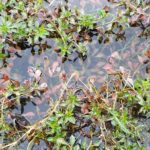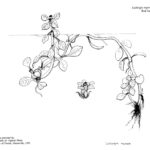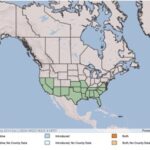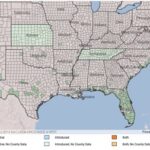Ludwigia repens
Illustration courtesy of University of Florida/IFAS Center for Aquatic and Invasive Plants. Used with permission.
What is Creeping Primrose?
Physical Characteristics
Leaves:
- Elliptical shaped
- 0.35-1.57 inches long
- 0.08-0.8 inches wide
- Leaf stalk 0.12-0.98 inches long
Flowers:
- 4 sepals, 0.09-0.17 inches long
- Petals 0.16-0.2 inches long
- Petals tend to disappear
- 4 stamen
- Fleshy
- 4 lobes
- Lobes opposite to the petals
Fruit:
- Short cylindrical shape
- 0.13-0.3 inches long
- 0.07-0.18 inches thick
Seeds:
- Several indistinct rows
- About 0.03 inches long
Stem:
- Up to 1.75 feet long
Roots:
- Creeping
- Rooting at nodes
Where Does it Grow?
USDA, NRCS. 2018. The PLANTS Database (http://plants.usda.gov). National Plant Data Team, Greensboro, NC 27401-4901 USA.
Creeping primrose can be found along streams, around ponds, in shallow water (floating on the surface), and wet mud on the edge of water bodies.
Pros and Cons of Creeping Primrose
Ducks and other waterfowl will consume the seeds of water primrose. Submerged portions of all aquatic plants provide habitats for many micro and macro invertebrates. These invertebrates in turn are used as food by fish and other wildlife species (e.g. amphibians, reptiles, ducks, etc). After aquatic plants die, their decomposition by bacteria and fungi provides food (called “detritus”) for many aquatic invertebrates.



